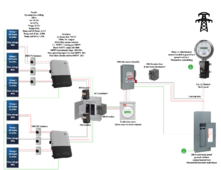TheFlumph
New Member
So after running into a roadblock with my 18kpv and backup plans with my utility (they require a separate production meter) Ive decided to go net metering only for now. Im gonna try to find two sunny boy 7.0 inverters (unfortunately just discontinued). They said I could keep my old plan and add a couple of inverters before the 18kpv and do ac coupled but thats just not in my budget so Im deleting the 18kpv and battery.
Please check my diagram. I think Ive got the DC side sorted here. What I need help with is combining AC after the inverters. Whats the best way to AC combine? A couple of 40a breakers going in and a 100a going out to the production meter? A bus bar coming in and a breaker going out?
also, please check my disconnect to line tap. What OCP do I need between the disconnect and tap, or should I just do a fused disconnect?
I know my meter/main breaker and main house panel is funky with the two neutral bonds. I can always run a ground from the outside meter and delete the neutral bond inside if the utility doesn't like it. No city/county inspections here. This is how they installed it 20 years ago.
I decided to go line tap because my panel bus bar is (I think)225a and ive got a 200a breaker in it. #30ax2x1.25 is 75a. I could only do max 70a backfeed breaker.
also, anyone with sunny boy experience, If i went with the 7.7kw model, could I limit them to be under 15kw together? My net metering agreement is for 15kw and under.
Thanks so much. This forum is wonderful.
 will be limited to 15kw and below.
will be limited to 15kw and below.
Please check my diagram. I think Ive got the DC side sorted here. What I need help with is combining AC after the inverters. Whats the best way to AC combine? A couple of 40a breakers going in and a 100a going out to the production meter? A bus bar coming in and a breaker going out?
also, please check my disconnect to line tap. What OCP do I need between the disconnect and tap, or should I just do a fused disconnect?
I know my meter/main breaker and main house panel is funky with the two neutral bonds. I can always run a ground from the outside meter and delete the neutral bond inside if the utility doesn't like it. No city/county inspections here. This is how they installed it 20 years ago.
I decided to go line tap because my panel bus bar is (I think)225a and ive got a 200a breaker in it. #30ax2x1.25 is 75a. I could only do max 70a backfeed breaker.
also, anyone with sunny boy experience, If i went with the 7.7kw model, could I limit them to be under 15kw together? My net metering agreement is for 15kw and under.
Thanks so much. This forum is wonderful.
 will be limited to 15kw and below.
will be limited to 15kw and below.


